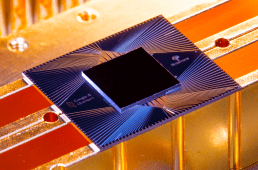Quantum Computing’s Wright Brothers’ Moment

On Oct. 23, the team at Google announced it had hit a technological milestone that scientists have been theorizing about for over 30 years: quantum supremacy. Some rejoiced at the great leap forward for the future of computing. Others, particularly the team at IBM, took umbrage with Google’s results — saying that it hadn’t quite really reached the milestone it claimed with its Oct. 23 calculation.
But for the vast majority of those who heard the news — the primary reaction was neither excitement or incredulity — it was just old fashioned confusion. Outside of a handful of experts and deeply interested enthusiasts — most regular consumers looked at each other and asked the same question:
What is quantum supremacy and what’s in it for me?
And, as Peter Chapman, CEO at IonQ told Karen Webster, there are a few ways to answer that question.
 In the strictest technical terms, he said, achieving quantum supremacy means that one has a quantum computer that can demonstrably be used in a way a regular computer cannot — or at least cannot be used feasibly. Google, for example, used its computer to solve an equation in under four minutes that would have taken the fastest computer on Earth about 10,000 years to solve (IBM disputes that result, saying they could do it in 3.5 days using the Oak Ridge supercomputer they installed last year).
In the strictest technical terms, he said, achieving quantum supremacy means that one has a quantum computer that can demonstrably be used in a way a regular computer cannot — or at least cannot be used feasibly. Google, for example, used its computer to solve an equation in under four minutes that would have taken the fastest computer on Earth about 10,000 years to solve (IBM disputes that result, saying they could do it in 3.5 days using the Oak Ridge supercomputer they installed last year).
But, as Chapman noted, for the average person, that technical definition isn’t too meaningful — particularly when you start trying to dig into exactly what it was Google accomplished a few weeks ago, and how they did it.
“The problem with the current announcement is very technical. You need to have a PhD in quantum mechanics to really understand what it means,” he noted.
But even if one doesn’t understand the exact meaning of what Google did — or the various rebuttals that have since sprung forth — the major takeaway that everyone should appreciate now is that quantum computing has crossed out of the realm of the theoretical — and into the possible. The signal, he said, has gone out to programmer and developers worldwide — and the next question to ask, he said, is what the applications and improvements that will soon be possible now that quantum computing is soon to be on the table in earnest.
In that vein, IonQ and Microsoft announced a partnership Monday (Nov. 4) to launch Azure Quantum — a full-stack, open cloud ecosystem that will make IonQ’s quantum computers, commercially available via the cloud. And the announcements, Chapman said, will likely keep coming at a quick pace from here.
“There are a bunch of landmines out there in software as software engineers are developing cheats to get around elements of programs that would just take forever to fund. The current bruhaha matter because it signals to the rest of the world that quantum is coming — and could change and perfect a lot of how calculations are done today with classical machinery.”
A Wright Brothers’ Moment
Had you been on the beach in Kitty Hawk in December of 1903 when Orville and Wilbur Wright first took flight 116 years ago — there is a good chance you might have missed it even if you had been standing on the ground underneath it. It was, after all, only 12 seconds long.
 But it was a significant 12 seconds because in that time period Orville and Wilbur had offered a proof point — powered air travel was possible and just needed some improving. Seven years later, the first commercial flight took off.
But it was a significant 12 seconds because in that time period Orville and Wilbur had offered a proof point — powered air travel was possible and just needed some improving. Seven years later, the first commercial flight took off.
The recent advance in quantum computing, Chapman told Webster, is something of a similar Wright Brothers’ moment. What was accomplished, he noted, is a technical marvel that only a few people will understand. What is now possible, he said, could very well make major changes to the lives of millions in big ways and small.
Because classical computing, as any programmer attests to, has hard complexity limits for programs before they start running so slow as to be unworkable. It’s why your Uber driver’s GPS instructs it to take less than efficient routes, why supply chain logistics can be so cumbersome and inefficient, why computer models in biotech come with such a margin of error baked in. Behind those inefficiencies and imperfections, he noted, there is always a programmer who has had to take a shortcut or use a cheat to make the program run correctly, even if that means sacrificing optimal accuracy.
What a quantum supreme world will eventually mean is those cheats won’t have to happen — the processing capacity necessary will be provided at speed sufficient to handle massive amounts of complexity.
When is that happening?
Well, that is a tough question to answer at this moment. For the same reason, it would have been difficult to get an accurate prediction on when the Concord would take its first flight back in December of 1903. What Google accomplished is an impressive feat that leverage qubits (quantum bits — the underlying technology that powers quantum computing). That’s a start — he noted, but to “really do interesting things” with quantum computing, one will need quite a few more qubits.
We are excited to announce the results of our quantum supremacy experiment. Using a fully programmable, 54-qubit processor, called “Sycamore”, we have performed a calculation in 200 seconds that’s infeasible on the fastest supercomputers. Learn more ↓ https://t.co/2qaiPap314
— Google AI (@GoogleAI) October 23, 2019
Intel rather passionately forecasts it would take millions of qubits to make anything significant happen in the wake of the Google announcement. That statement, Chapman noted is both true and a bit misleading.
“The takeaway is that there are different ways to optimize how the circuits run. So Intel is making a correct statement about their technology. Other estimates will take 100 to 150 cubits at a minimum. With our system, we think probably 80 to 100 qubits is the number that moves us closer to using the technology to solve real problems.”
As for what those real problems will look like that, Chapman said, is the hardest question to answer of all.
The Exciting But Murky Future
In the 1970s when the real full-court press went on to develop computers into their modern instantiation, Chapman said, the most common recurring idea about the technology was that one day, with a lot of work and effort, these machines would make excellent calculators.
You can’t say they were wrong exactly, so much as they underestimated all the other things for which computers were going to be used.
“I think if we redo this interview 5 to 10 years from now, you would look back at the things we thought were going to be the big uses for quantum technology and be impressed by how little imagination we showed,” Chapman said.
There are a host of places where they can see quantum computing living up to its fullest potential could make massive strides — in healthcare, security, logistics, transportation — the number of places where being able to be more accurate and precise is almost unlimited.
How those developments are going to flow out — that is up in the air. It is entirely possible that right now there is a kid sitting in a middle school or a high school that is a few short years from developing the killer application for quantum computing in a garage in the suburbs. And the thing about garage innovations is they are pretty unpredictable, and so Chapman is pretty sure there is a lot more that we don’t know about the future of quantum computing than there is stuff we do.
But, he said, at this point we don’t know anything either — other than we know it is coming.
The time between now and that killer app is an interesting period for corporations and individuals. “We aren’t at 100 cubits yet, but we will be in 18 months and with enough quality to see really interesting applications starting happen,” Chapman remarked.
